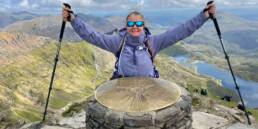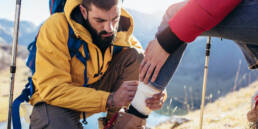Photo © Kalen Emsley
More and more people are venturing out in to the mountains on their own and it’s no wonder when you consider the amount of space and the abundance of peaceful solitude available. It’s perfectly possible to go a whole day without bumping in to anyone and whilst this won’t be the case on the Llanberis Path at lunchtime on a summer weekend, if you set off early enough and climb one of the quieter routes such as the Snowdon Ranger path you’ll definitely have a quieter experience.
If you’re worried about your personal safety or even getting lost on Snowdon, then if you stick to the main footpaths and you’re hiking on a weekend you’re never likely to be on your own! Snowdon is a very busy mountain and there’s always someone to say ‘hello’ to.
There are a few considerations to take in to account however as there are obviously greater risks when exploring remote areas alone. Never be afraid of walking on your own. Just take a few extra precautions to ensure your safety on Snowdon.
Tell someone what you’re doing
It sounds simple but it’s the most obvious thing. Be sure to let a loved one or friend know that you’re going for a walk on your own and give them some information that might be useful if anything were to go wrong.
Let them know where you’re planning to go, where you’re going to start from and a rough idea of what time you’ll be back. If you’re following a set route for example from the back of this book or from another source or if you’ve prepared a route card yourself then leaving a copy of that behind is also really useful. And of course, be sure to let your contact know when you’re home safe.
Talk to people
The Countryside Code even says so! Everybody loves a ‘good morning’ or ‘how’s your day going?’ as you pass each other and particularly more so when you’re walking alone and come across other lone walkers. You can usually tell whether someone is quite happy with a head nod and who’s up for a bit of a chat. People walking in the countryside are nearly always friendly folk and it’s always amusing how chatty people can be with each other compared to how they might behave walking along a street in their home town. If you’re on your way down a hill passing others on their way up, people always want to know if they’re ‘nearly there yet’ and giving them a bit of motivation can make all the difference.
Invest in a Personal Locator Beacon
When you move on from being a ‘beginner’ and find yourself often walking alone particularly in exposed and remote regions you may want to consider investing in a personal locator beacon (PLB). Traditionally used by those at sea they’ve been licensed to use inland since 2012 and even though in the UK the system is managed by the Maritime & Coastguard Agency (MCA), as the devices typically broadcast your GPS location, they will be able to tell that you’re up a mountain and not at sea and liaise with mountain rescue services to get help to you. PLBs don’t rely on mobile phone networks and so are particularly useful in remote parts of the country.
When activated, along with your location they also transmit a unique code which can be matched with information held in the UK Distress & Security Beacon Registry. The emergency services will use this information to attempt to contact you and your next of kin to ascertain more about the situation and to ensure the activation is genuine so it’s essential that when you buy a new one or move house you update your details with the MCA.
The devices are small, rugged and lightweight. There are no monthly subscriptions and the battery life should last upwards of six years. You’ll typically expect to pay around £200 so at this price it’s definitely an investment and really only for those who are perhaps exploring ‘off grid’ more than a weekend hiker.
The main downside of PLBs is that the communication is only one-way so you’re really only going to want to use them in the most serious emergency and when you can’t get hold of mountain rescue using a mobile phone.
Remember your mobile phone
An absolutely necessity in this day and age. Make sure you have your mobile phone with you, make sure it’s fully charged before you start your day and make sure it’s somewhere dry and secure. Ideally carry a battery bank with you too.






